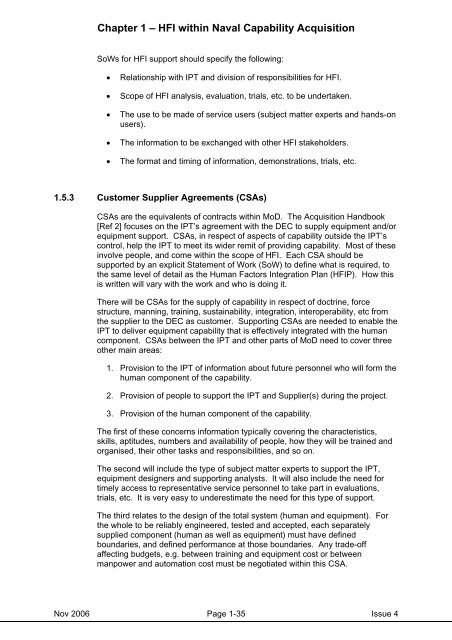MAP-01-010 HFI Management Guide - Human Factors Integration ...
MAP-01-010 HFI Management Guide - Human Factors Integration ...
MAP-01-010 HFI Management Guide - Human Factors Integration ...
You also want an ePaper? Increase the reach of your titles
YUMPU automatically turns print PDFs into web optimized ePapers that Google loves.
Chapter 1 – <strong>HFI</strong> within Naval Capability Acquisition<br />
SoWs for <strong>HFI</strong> support should specify the following:<br />
• Relationship with IPT and division of responsibilities for <strong>HFI</strong>.<br />
• Scope of <strong>HFI</strong> analysis, evaluation, trials, etc. to be undertaken.<br />
• The use to be made of service users (subject matter experts and hands-on<br />
users).<br />
• The information to be exchanged with other <strong>HFI</strong> stakeholders.<br />
• The format and timing of information, demonstrations, trials, etc.<br />
1.5.3 Customer Supplier Agreements (CSAs)<br />
CSAs are the equivalents of contracts within MoD. The Acquisition Handbook<br />
[Ref 2] focuses on the IPT’s agreement with the DEC to supply equipment and/or<br />
equipment support. CSAs, in respect of aspects of capability outside the IPT’s<br />
control, help the IPT to meet its wider remit of providing capability. Most of these<br />
involve people, and come within the scope of <strong>HFI</strong>. Each CSA should be<br />
supported by an explicit Statement of Work (SoW) to define what is required, to<br />
the same level of detail as the <strong>Human</strong> <strong>Factors</strong> <strong>Integration</strong> Plan (<strong>HFI</strong>P). How this<br />
is written will vary with the work and who is doing it.<br />
There will be CSAs for the supply of capability in respect of doctrine, force<br />
structure, manning, training, sustainability, integration, interoperability, etc from<br />
the supplier to the DEC as customer. Supporting CSAs are needed to enable the<br />
IPT to deliver equipment capability that is effectively integrated with the human<br />
component. CSAs between the IPT and other parts of MoD need to cover three<br />
other main areas:<br />
1. Provision to the IPT of information about future personnel who will form the<br />
human component of the capability.<br />
2. Provision of people to support the IPT and Supplier(s) during the project.<br />
3. Provision of the human component of the capability.<br />
The first of these concerns information typically covering the characteristics,<br />
skills, aptitudes, numbers and availability of people, how they will be trained and<br />
organised, their other tasks and responsibilities, and so on.<br />
The second will include the type of subject matter experts to support the IPT,<br />
equipment designers and supporting analysts. It will also include the need for<br />
timely access to representative service personnel to take part in evaluations,<br />
trials, etc. It is very easy to underestimate the need for this type of support.<br />
The third relates to the design of the total system (human and equipment). For<br />
the whole to be reliably engineered, tested and accepted, each separately<br />
supplied component (human as well as equipment) must have defined<br />
boundaries, and defined performance at those boundaries. Any trade-off<br />
affecting budgets, e.g. between training and equipment cost or between<br />
manpower and automation cost must be negotiated within this CSA.<br />
Nov 2006 Page 1-35 Issue 4
















